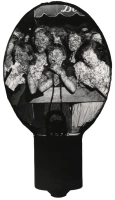Mike Disfarmer, [Unidentified Woman and Man in front of Cabin], 1930s
Mike Disfarmer, Arthur, Doreney, Artisee, Patsy, Oneda, Darlen, ca. 1940s
Mike Disfarmer, Eva Dean, Betty Jo, ca. 1940
Mike Disfarmer, [Unidentified Woman and Three Children], ca. 1935
Mike Disfarmer, [Unidentified Young Woman], ca. 1940s
He paid far more attention to people as artistic problems to solve, sometimes taking an hour to make a portrait, than as individuals with lives outside the studio. Richard B. Woodward, Disfarmer: The Vintage Prints. New York: Edwynn Houk Gallery, 2005, p. 210.
Mike Disfarmer (1884–1959) was an American photographer whose portraits of his Arkansas neighbors transcended the realm of studio portraiture. He is now well known for his photographs from Heber Spring, Arkansas, where he moved at the age of thirty, set up his own studio, and documented the town’s residents for forty years.
He has been labeled an eccentric character for the life he led and his behavior as a studio photographer. He explained the last decades of life almost as an “alien abduction,” creating a fictional story about his origins without any relation to his real birth in Indiana. Born Mike Meyer, he changed his name to Mike Disfarmer. He grew up in a farming community but never wanted to be linked with it, so he decided to change his name: he believed “Meyer” was German for farmer. “Dis” means no and so he erased his history and renamed himself “no farmer.”
He was really attracted to people’s appearances, a fact that we can really appreciate by looking at his pictures. He had strange behavior with his clients when he was photographing. “Instead of telling you to smile, he just took the picture, no cheese or anything. You did not even know when the picture was taken,” explains Tom Olmstead. Disfarmer was a solitary man; apparently he only had one friend, Albert Hendrix, with whom he used to play music some afternoons. Heber Springs resident Charlotte Lacery declared that “he was not talkative, he was and very spooky and scary.”
Who is responsible for making Disfarmer’s images available to the wider public?
In 1961, three years after Disfarmer’s death, Joe Allbright purchased all of the materials in his studio for $5. In 1973, he sold the ten to fifteen boxes of glass plate negatives to Peter Miller, a newspaper editor, for $1. Miller believed that Disfarmer images were special and spent a year preserving the images and cleaning the emulsion of the glass plates. Miller rescued between 3,000 and 4,000 negatives, made modern prints, and sent them to Julia Scully, editor of Modern Photography magazine. In 1976, Scully published a book, Disfarmer: The Heber Springs Portraits, 1939–1946: Disfarmer Photographs from Peter Miller, the Group, Inc., which coincided with an exhibition here at the International Center of Photography. Toba Tucker has extensively researched Disfarmer’s biography and made numerous trips to Heber Springs in 1989, where he interviewed many subjects photographed by Disfarmer. In recent years, collector Michael Mattis has spearheaded a major search for vintage Disfarmer prints in Heber Springs and Cleburne Country. Mattis also organized an exhibition of Disfarmer prints made from glass plate negatives in Heber Springs to capture the attention of the people who were in possession of original photographs by Disfarmer and another show of vintage prints was mounted in New York. Disfarmer’s neighbors also contacted New York gallerist and collector Steven Kasher about their photographs, many of which were eventually exhibited in New York.
Maybe because of his personal eccentricities or his unorthodox life, Disfarmer and his images have inspired a few artists. One interesting example is Bill Frisell, whose album Disfarmer (2009) combines Disfarmer’s images with an innovative musical language. Frisell’s music was also included in the 2010 documentary film Disfarmer: Portrait of America, directed by Martin Lavu. Dan Hurlin, a theater director, discovered Disfarmer and created a performance work based on his life.
It seems that this eccentric and strange character has inspired lots of artists and will probably continue to do so!






